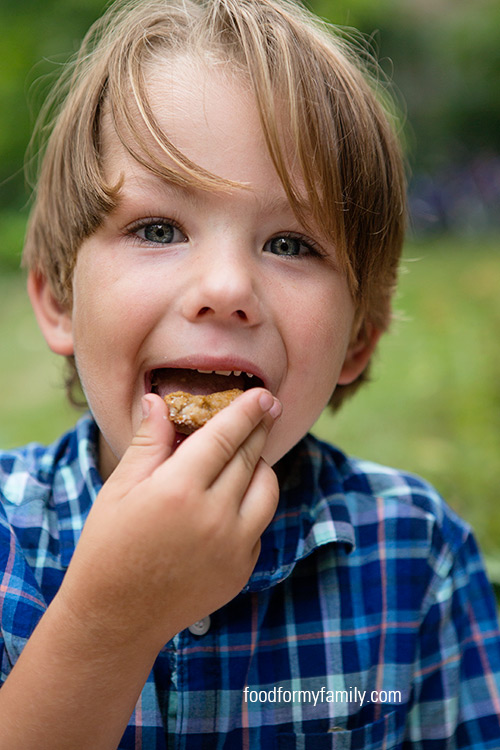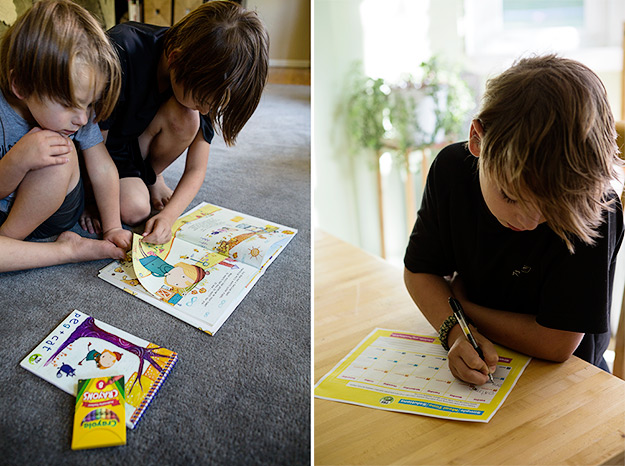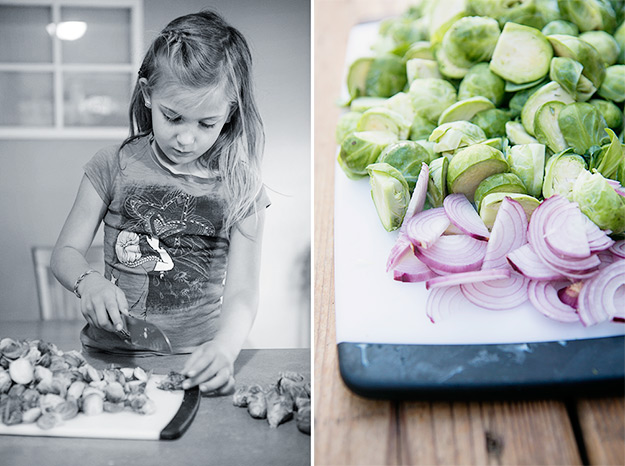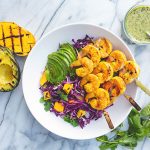The what, why, and how of getting your kids involved in menu planning and the discussion of daily meals.


I am in the kitchen, bent at the waist with my head tucked inside the refrigerator. Our fridge is always stuffed full with the season’s produce, wrapped in plastic or teetering in bowls. Each week I tell myself I need a better solution for organizing the Tetris-esque contents of my chilled rectangle.
On the shelf below the jars of yogurt and opened jams, amidst the lettuce, Brussels sprouts, and cartons of eggs, there’s a glass container holding a hunk of washed-rind cheese I purchased for an appetizer missing less than a third of its original mass. I grab it and a bunch of spinach that I neglected to use last week before grabbing a small container of prosciutto and adding it to my pile. Around the corner in the dining room is a bamboo bowl overflowing with the last of the summer squash, an overabundance of tomatillos, and enough shallots to last the winter, their purple papery husks crackling as I reach in to grab one.
My kids have requested macaroni and cheese, and what they help me prepare and what I serve them is a Taleggio sauce that is more creamy white wine sauce than it is cheese sauce, served up over sautéed greens and crisped prosciutto with a side of honey-drizzled roasted cauliflower. Decidedly not classic macaroni and cheese with thick yellow cheese sauce clinging to and coating the surface of each piece of pasta. Yet not one of four children protests the treatment of macaroni and cheese into this modified version.
I do not believe I am a magician nor do I believe I lucked out four times in having kids who choose to eat their vegetables more often than I need to request for them to do so. In fact, my youngest politely told me after eating two pieces of cauliflower that “white broccoli is not tasty for me.” My oldest would be quick to inform you that asparagus is from the devil himself, and my younger daughter will recoil at the sight of coleslaw on the table. So why were slimy greens and roasted cauliflower so willingly accepted on the table for dinner that night? In part, it was because they were involved in the process.

Why it is Important to Involve Your Kids in Menu Planning
Conversations about and around food are wonderful, but they don’t provide experience. I could tell my children that carrots keep your eyes sharp and spinach grows Popeye-like muscles until I’m blue in the face, but peer pressure asserted by children’s menus and advertising on television tells them a different story entirely. With both sides weaving different tales about what food they should choose to put in their body, who is your child to believe?
The act of involving them in the process of planning what you should eat is an important step in raising healthy eaters and kids that accept what is on the table at breakfast, lunch, and dinner.
- Give them a choice. Simply giving a child a choice between green beans or broccoli can empower them to feel good about scooping that dish onto their plate. They’re seeking ownership over what they put into their body, and giving them that onus over their food options is a wonderful step in eliminating the need for them to tell you “no” just for the sake of telling you no.
- Exposure is half the battle. Having kids exposed to food options before they land on their plate takes half the battle out of dinnertime. Not everyone likes surprises, and even fewer of those surprise-hating folk like to be surprised about what they then get to chew and swallow repeatedly. Along with creating ownership over the meal, giving your kids food choices will take the revelation portion of the meal and distance disappointment from dinnertime and also make favorite dishes come with a level of anticipation. It is a two-way street.
How to Incorporate Menu Choices
Now, I’m not suggesting you give your kids executive control over grocery shopping habits and meal planning, at least not yet. Instead, I’m suggesting that you start like you’re teaching them how to ride a bike without training wheels: practice, exposure, and slowly letting go of the iron grip on the back of the seat.
- Start with a simple choice. Take a look at what your dinner side options are and give your child a choice: Do they want green beans or broccoli with dinner? These small options will allow them options between very like ingredients that don’t change the overall meal, but will feel like a small bit of ownership over that dish.
- Shop with them. Transfer the choice from what you might have on hand to the grocery shopping experience. Point out the vegetables they can choose from at the market:Do you think we should have the purple asparagus or the flower-like artichoke hearts for dinner tomorrow? Moving it to the shopping experience opens up the possibilities more for them, and it’s a wonderful time to talk about food options.
- Bake it, steam it, fry it, sauté it. Once your child gets a sense for how choosing side dishes is done, start asking them how they’d like to prepare the item of choice. Do they want to steam the broccoli or cook it in a casserole? Should we bread the asparagus and bake it or wrap it with prosciutto? This treatment of foods can help them explore new ways that they might like foods that they previously thought they didn’t, and it can help them think about how food taste and texture change depending on how they are prepared.
- Kids’ night specials. Next, of course, is encouraging them to combine all of that into choosing a full menu. Discussions about a variety of foods, what the ratio of protein to produce should look like, and more can be had as they choose what to serve for a meal. This helps them think about why all the food you are serving meal in and meal out is making an appearance. “No, [you] don’t serve salads and steamed vegetables just to torture them. They are actually good for you.” “Yes, [you] like chocolate cake, too, but it’s all about moderation and balancing it out with good choices for dinner beforehand.”
- Lunch box learning. After grocery shopping, make lists of what items you have available for different parts of their lunches and have them choose from the items when packing their lunch or snack. My kids know they need an entree item, at least one fruit, a vegetable, and a healthy snack. Cross items out when they are used or you run out.
Yes, I know these aren’t foolproof methods. I understand it can be discouraging the first time you try this and your child still turns a sickly shade of green before their head spins straight around on their shoulders as dinner is served. Please, let’s try to remember that children are human, and just like you raised your voice unnecessarily because of stress, snapped at your husband just because, or you simply weren’t in the “mood,” children can have the same reactions. We’re not infallible, after all.
Don’t get frustrated immediately or throw your hands up and call the battle lost. Pick up the discarded food and try again tomorrow or in a few days.

I was recently approached by PBS and Whole Foods to view a screening of Peg + Cat, and when the box arrived it contained a great picture book, menu planning sheets, and a few other activities that showed how multifaceted the act of menu planning can be: looking at math problems ranging from simple addition and multiplication to division, discussing organization and real world problem solving. “If we are going to make six servings of rice and one serving is 1/4 cup dry, how many cups of rice do we need?” “If one half-gallon of milk costs $3.50 and one gallon of milk costs $5.75, which is the better deal?” “If we buy eight bananas, how many times can the four of us each have a banana for breakfast?” Plus, reading recipes and figuring out quantities and pantry items will give kids and appreciation for how their food comes to be, and Peg + Cat are pretty cute when they’re asking you to count bananas and chickens. It is a great introduction for young kids to math.
PBS Kids and Whole Foods asked me to share my experiences with you as their new series Peg + Cat debuts. However, their partnership ended as September came to a close, so this post is simply because I wish to share. Additionally, all of these thoughts are my own. You can check out Peg + Cat on PBSKids.org and find programming times in your area, plus get healthy meal ideas, do activities, play games, and more. If you haven’t sought out the kids’ club portion of your local Whole Foods, they are a wonderful resource for healthy recipes, cooking classes, food education, and more depending on your store’s offerings.






I couldn’t agree more with this! Child-involvement with appropriate parameters has worked wonders in my house. My kids each have preferences and opinions that I respect and appreciate but I’m definitely not running a restaurant (aka “what would you like to order today, dearie?”) I have found that above all else, exposure – through choice, shopping and ingredients in dishes – has had profound effects on my kids’ tastebuds. Great post!
This is a good reminder, Shaina. I have a tendency to plow ahead and not include the boys. Now Clara, she’ll eat anything, but they are the ones with little opinions. 🙂
Great tips, Shaina! Thank you for sharing! 🙂
This is such a great post Shaina, I wish I had involved my girls more when they were little. Luckily now at 25 & 17 they eat much better than they did when they were younger.
This is such an important post! I too have noticed that when I involve the kids in the kitchen, they are a lot less picky at the table. For some reason though, I hadn’t really thought about having the kids help pack their lunchboxes too – great idea and one I’m going to start using right away!
I love this post, Shaina. It’s so important to me that EJ have a better view of food than I ever did, and you are definitely my hero in that regard. I’ll be looking to you muchly over the years, my friend. And bookmarking this post to read again and again.
Getting kids involved with their food is so important, thank you for the great tips!
I am passionate about this subject and I LOVE that there are actually kits out there to help kids menu plan! So cool!
This is a wonderful post, Shaina. Getting our kids involved in all aspects of meal making is so important!!
I love that you are involving the kids in the planning of the weekly meals! They love to help, and are usually really proud of what they’ve helped to create!
My kids love to help out in the kitchen and I think it is so inspiring the way you encourage your kids to get involved!
I need to remember to let me kids participate in the meal planning more often. I think they would be more excited about meals. Thank you for this great post.
It is so true – love all the teaching that goes on in the kitchen. Great information Shaina – thanks for sharing!
I know you wrote this last year, but the message you give in this post is timeless. It’s incredible what a difference it makes when I involve my kids in the whole process of meal planning. And as they get older (they’re 8, 6 & 4), they are able to participate more and more. So thank you for the wise words as we go into Fall food season.
Works for all fussy eaters!
I wouldn’t consider having a partner who doesn’t contribute, and the more I involve my husband in shopping, cooking and gardening, the more open-minded he becomes for new foods.
His own cooking continues to blossom…makes his own brown beer bread and blonde beer pancakes for sourdough flavor. He also brews Jun and Mead using the raw honey we harvest from our honey bee hives (most honey we leave for the bees, themselves).